TRINITY AND VEDANTA
When I sat down to write my monthly blog on the Trinity West and East, I really thought that I had bitten off more than I could chew. I still think that. But when I started by defining terms, it did come together. Though it is still like a schoolboy who has just learnt his twelve times tables trying to tackle the Cambridge Maths Tripos. For what it’s worth, here is my attempt.
DEFINITIONS – the West
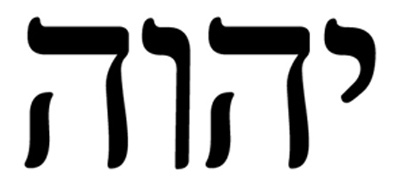
Jewish thought
Jews are insistent that there is one source of divinity. ‘Hear, O Israel, Yahweh your God, Yahweh is one.’ Or as modern Liberal Judaism might put it, ‘Hear, O Israel, the Eternal your God, the Eternal, is one.’ The world is the creation of God, and itself worships the Eternal One. He is active in history and communicates to those who obey his words.
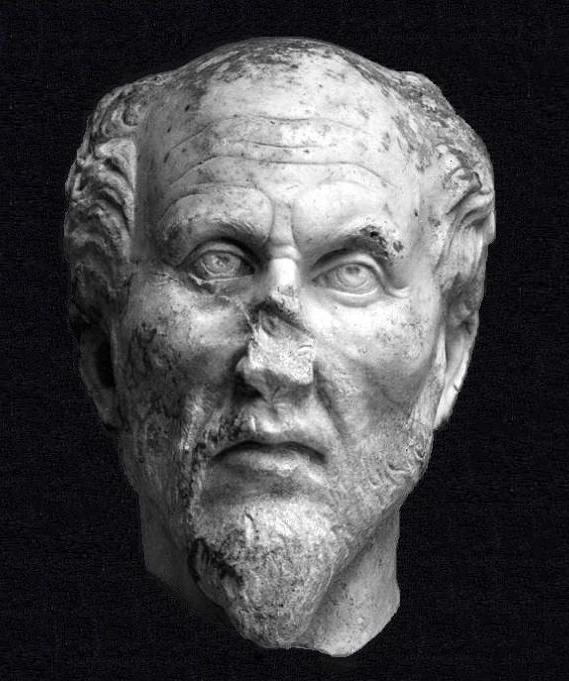
Greek thought
Religious thought in the Greek world started with accepting a multiplicity of gods whose worship kept the world friendly, or provided power to navigate life. Stoicism said there was nothing beyond the material universe. Neoplatonism (3rd c. CE) was monist, saying that all reality derived from a single principle, ‘the One’, which is beyond all categories of being and non-being. Central to Christian thought of the time was that God, the ultimate, was ‘impassible’, i.e. unable to be changed or acted on or affected by anything.
The Jesus experience
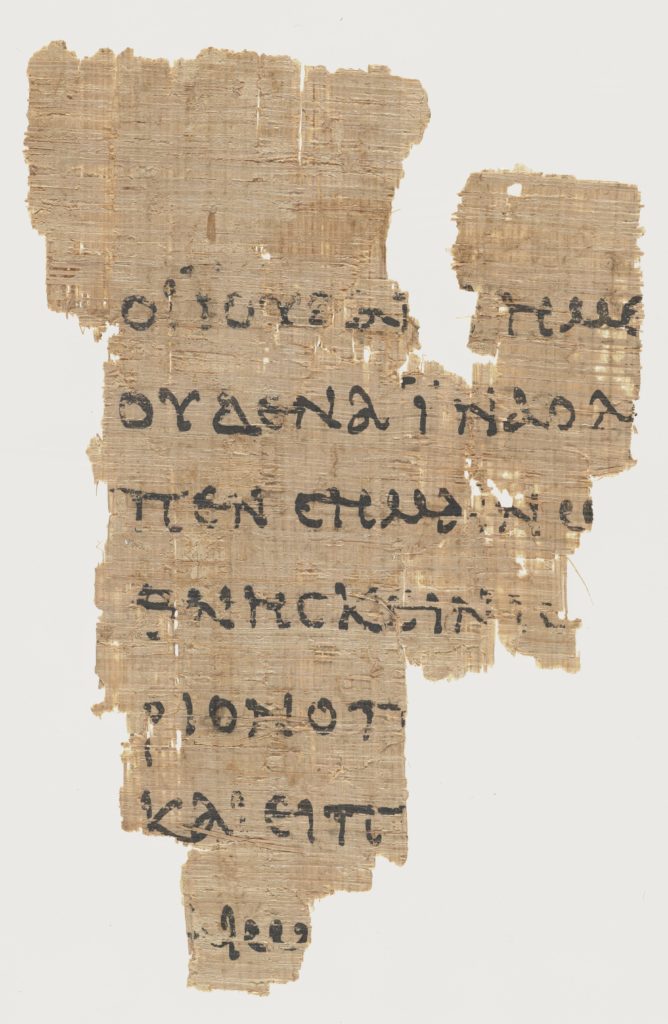
For the first hundred years, the new Christian community was based in Jerusalem. All the bishops of Jerusalem were Jews, ‘of the circumcision’, up to Bar Kochba’s revolt in 132 CE. The belief was in one God, who acted in the world. Jesus was seen as more than a teacher and prophet, and ‘was declared Son of God with power according to the spirit of holiness by resurrection from the dead.’ (Romans 1.4). The Spirit was the one who ‘works miracles among you.’ (Galatians 3.5). Trying to make sense of this has been the Church’s task ever since.
Trinity
The word ‘Trinity’ was first coined by Tertullian around 200 CE. It means Three-in-One, referring to the Christian Church’s understanding of how the Father, Son and Holy Spirit could be both three and one. Whether that meant the three ways that God interacts with the world or whether it describes God’s essential nature was hotly contested over the next two centuries.
DEFINITIONS – the East
Vedanta – the Indian/Hindu systems of philosophy and religious speculation based on the Upanishads, Bhagavad Gita and Brahma Sutras. The Upanishads were written over a thousand years from (possibly) 7th century BCE. The Vedantic commentaries/speculations developed from the 7th century CE up to the present.
Putting it VERY simply, there are three main positions:
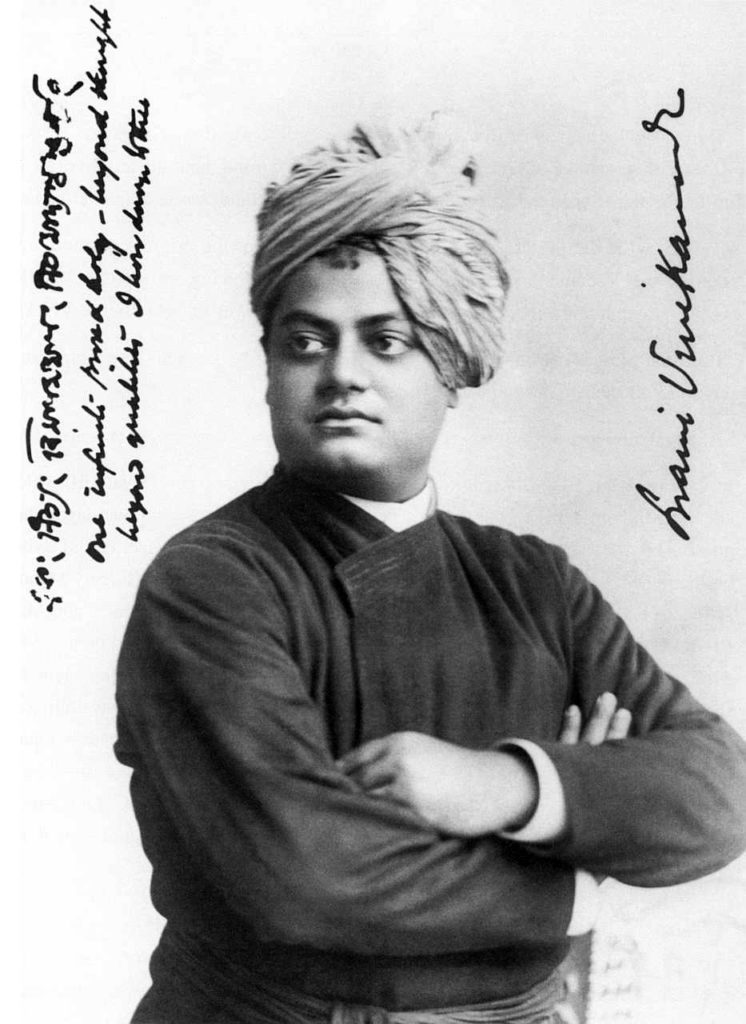
Advaita meaning non-dualism. Sankara (9th CE) is the most important exponent of the Advaita or non-dual philosophy. In this all phenomena, including divinities, are of a secondary order and will ultimately be absorbed in the Absolute (Brahman) as a drop of rain is absorbed by the ocean. Vivekananda (1863-1902) popularised it at the Parliament of the World’s Religions in 1893, making it is the main understanding of Vedanta in the Western world. It has influenced philosophers like Spinoza, R W Emerson, Hegel and Schopenhauer.
Vivekanda 1893. He wrote here: “One infinite pure and holy – beyond thought beyond qualities I bow down to thee”.
Advaita has four ‘great sayings’, the mahavakya
- Aham brahmāsmi – Self is Absolute
- Prajñānam brahma – knowledge is Absolute
- Ayamātmā brahma – this [individual] Self is that [universal] Absolute
- Tatvamasi – Thou art That
Dvaitadvaita meaning dualism or natural identity-in-difference. It expounds the relation between Brahman and Atman, the Absolute and the soul. The soul and the universe are both identical with and dependant on Brahman alone.
Vishishtadvaita meaning qualified non-dualism. Ramanuja (11th c. CE) is the most important advocate of Vishishtadvaita. He expounded the importance of ‘bhakti’ or devotion to a personal God as a means to spiritual liberation. A typical ‘Bhakti ‘hymn could well be ‘Amazing grace’.
THE PROBLEM OF THE TRINITY -THE WEST
The problem of the Trinity can be summed up in the quote in the Gospel of John, ‘I and the Father are one.’ What does this mean?
It could mean that there is a unity of will between Jesus and the eternal Father. That he was an inspired man – perhaps THE inspired man, that the relationship of Jesus of Nazareth with the Father was so close that Jesus naturally thought God’s thoughts. ‘The Father and I are one.’
Alternatively, it could mean that Jesus expressed in human form the actual essence of God in his eternal unity of being. In the light of eternity, there is no necessary distinction between God in himself and the One we perceive as the radical rabbi from Galilee. ‘The Father and I are One’.
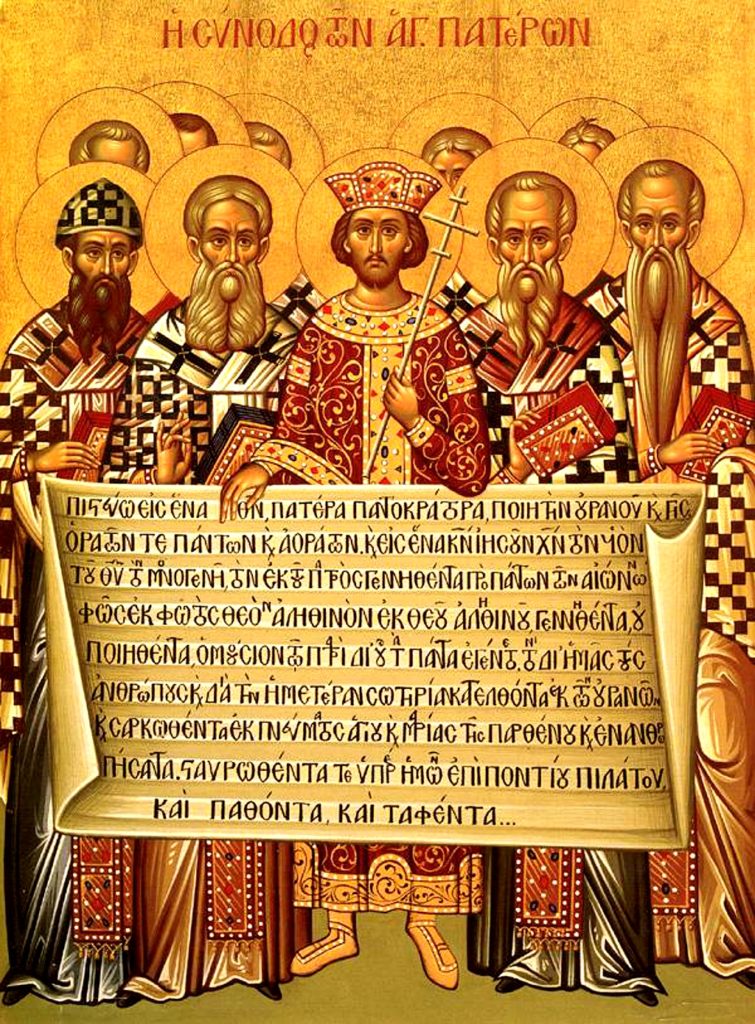
We could further say that he was the eternal creator of the universe, again seeing this expressed in the human person of Jesus, ‘The Father and I are one.’ But if so, did his coming into being pre-date the creation of the universe, but post-date the eternal nature of the Father? This latter is what the Alexandrian priest Arius taught in 318 CE. The ensuing uproar culminated in the Council of Nicaea seven years later.
The Council adopted the phrase ‘God from God, Light from Light, true God from true God, begotten not made, of one substance with the Father…’ This last phrase was the crucial innovation of the Council and describes the eternal nature of God the Son. Arius and his supporters preferred the term ‘of one likeness to the Father’. This was rejected because it implied a hierarchy within the Godhead, while the phrase ‘of one substance’ defended the complex simplicity of the Godhead. Or something like that.
‘I and the Father are one’ is also a favourite Bible verse for Hindus. Vivekananda wrote, ‘You are all Sons of God – Immortal Spirit. Dare to stand up and say, not only “I am the son of God”, but also to find in your hearts, “I and the Father ore one!”’
THE PROBLEM OF THE REAL – the East
The key Hindu prayer is: Lead us from the unreal to the real.
Lead us from darkness to light.
Lead us from death to immortality.
The question is, what is the real?
Nirguna Brahman: The Vedanta teaches that the ultimate real, the Absolute is Nirguna Brahman, the Absolute without attributes, about which one can say nothing. In the Christian contemplative tradition, the Via Negativa, one aims to come face to face with the One about which we can say and know nothing. We meet him in ‘the Cloud of Unknowing’. In the Vedanta the Supreme is the One who is nothing – yet is the ground of liberation. Liberation is liberation from the unreal, from the whole universe of phenomena.
Saguna Brahman is the Absolute with attributes, the One who can lead us to liberation. This is given form in the guise of God or gods. For Vaishnavites God is Vishnu, who is revealed in Krishna, the God whose coming as man is related in the Bhagavad Gita.
‘Although I am unborn, the Lord of all living entities, and have an imperishable nature, yet I appear in this world by virtue of my divine power.’ (4.6)
For Saivites, God is Shiva, but only as a secondary mode of Saguna Brahman, who is only a secondary mode of Nirguna Brahman. All that is unreal will be swallowed up in the real. This is what Sankara taught, I think.
For those who follow Vishishtadvaita, qualified non-dualism, Saguna Brahman is not inferior to Nirguna Brahman. Although through Saguna Brahman we are led beyond the unreal, this world of phenomena, there is a certain reality remaining in the relationship between devotees and Brahman, based as it is in loving devotion. I spoke to a Roman Catholic priest in Madras/Chennai, who said to me that qualified non-dualism was the best fit for a Christian understanding
The key mode in which Saguna Brahman is understood/experienced is in the Atman. Atman means breath or spirit. (The German word Odem or breath is a clear descendant from the Sanskrit). So the presence of the Absolute is perceived in us as spirit or Atman, and as Spirit or Paramatman (Supreme Atman) in the universe. Paul has a similar understanding when he says in Romans: ‘it is the Spirit himself bearing witness with our spirit that we are children of God.” (Note that the capitalisation of one word and not another is just an editorial elaboration. When the New Testament was written all letters were upper case).
OTHER TERMS
Maya describes the unreality of this world. It is the powerful force that creates the cosmic illusion that the phenomenal is real. It has a connotation of misleading magic. But it could simply be a word for contingent being, reliant solely on the creative and preservative power of the Absolute.
Moksha means liberation, release, nirvana. It is the utmost aim of human life.
Karma is the cosmic law of cause and effect.

OM or AUM is the creative sound behind the universe. When it is chanted or hummed, the Absolute is there. It has no meaning as such but evokes the Supreme.
It is also seen as a shorthand for the three major personal gods, using the last letter of their traditional names, namely Brahma the creator, Vishnu the preserver, and Shiva(m) the destroyer. This is known as the Trimurti, and some Christian have been tempted to use it to explicate the Trinity. That would be a mistake, as the Trimurti is at a level below the supreme and absolute Brahman. It would relegate devotion to Jesus as simply one’s ‘ishta deva’, one’s own personal god.
SACCIDDANDA
The Supreme, the Absolute, the Ultimate Reality, that which is beyond all sense-perception or thought, is nowhere defined or described in the Upanishads except in the phrase sat – cit – ananda, or existence – consciousness – bliss. Even Sankara was prepared to describe it in this way.
It is possible to express it in clearly Biblical words. ‘Sat’ means Being, as when God proclaims I AM” ‘Cit’ is parallel to ‘Logos’ (communication). ‘Bliss’ is perfectly reflected in Paul’s phrase, ‘joy in the Holy Spirit’. (Romans 14.17).
The great Christian Brahmabandhab Upadaya (1861-1907) expressed his devotion to the Trinity in the following marvellous hymn:
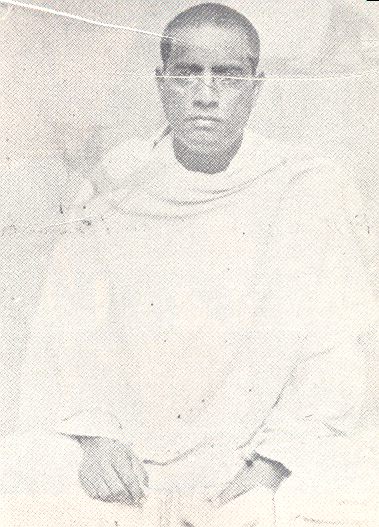
- I bow to Him who is Being, Consciousness and Bliss.
- I bow to him whom worldly minds loathe, whom, pure minds yearn for,
- the Supreme Abode.
- I bow to him whom worldly minds loathe, whom, pure minds yearn for,
-
- He is the Supreme, the Ancient of Days, the Transcendent,
- Indivisible Plenitude, Immanent yet able all things,
- Threefold relation, pure, unrelated
- knowledge beyond knowledge.
- Threefold relation, pure, unrelated
- Indivisible Plenitude, Immanent yet able all things,
- He is the Supreme, the Ancient of Days, the Transcendent,
-
- The Father, Sun, Supreme Lord, unborn,
- The seedless seed of the tree of becoming,
- The Cause of all, Creator, Providence, Lord of the universe.
- The seedless seed of the tree of becoming,
- The Father, Sun, Supreme Lord, unborn,
-
- The infinite and perfect Word,
- The Supreme Person begotten,
- Sharing in the Father’s nature, Conscious by essence,
- Giver of true salvation.
- Sharing in the Father’s nature, Conscious by essence,
- The Supreme Person begotten,
- The infinite and perfect Word,
-
- He who provides from Being and Consciousness,
- Replete with the breath of perfect bliss,
- The Purifier, the Swift, the Revealer of the Word,
- the Lifegiver.
- The Purifier, the Swift, the Revealer of the Word,
- Replete with the breath of perfect bliss,
- He who provides from Being and Consciousness,
RESPONSE
The best response to the revelation is silence. So I am leaving it there.
If anyone would like to take part in a zoom meeting to discuss this, please drop me an email.
______________________________________________________________________________
BOOKS USED
Frances Young The Making of the Creeds
Robin Boyd Indian Christian Theology
R Pannikkar The Trinity and the Religious Experience of Man
Vivekananda Foreword to booklet ‘Thus spake the Christ’
0 Comments